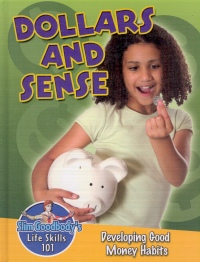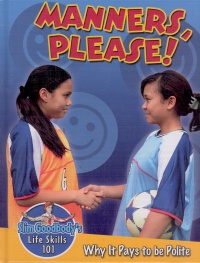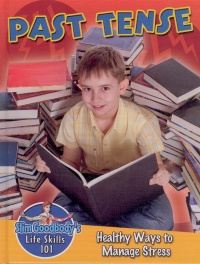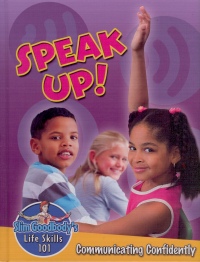| ________________
CM . . .
. Volume XVII Number 15. . . .December 10, 2010 
 |
Dollars and Sense: Developing Good Money Habits. (Slim Goodbody's Life Skills 101).
John Burstein.
St. Catharines, ON: Crabtree, 2011.
32 pp., pbk. & hc., $9.95 (pbk.), $20.76 (RLB.).
ISBN 978-0-7787-4810-6 (pbk.), ISBN 978-0-7787-4794-9 (RLB.).
Subject Headings:
Children-Finance, Personal-Juvenile literature.
Money-Juvenile literature.
Finance, Personal-Juvenile literature.
Grades 3-4 / Ages 8-9.
Review by Gail Hamilton.
** /4
|
| |
|
 |
Manners Please! Why It Pays to be Polite. (Slim Goodbody's Life Skills 101).
John Burstein.
St. Catharines, ON: Crabtree, 2011.
32 pp., pbk. & hc., $9.95 (pbk.), $20.76 (RLB.).
ISBN 978-0-7787-4811-3 (pbk.), ISBN 978-0-7787-4795-6 (RLB.).
Subject Heading:
Etiquette-Juvenile literature.
Grades 3-4 / Ages 8-9.
Review by Gail Hamilton.
** /4
|
| |
|
 |
Past Tense: Healthy Ways to Manage Stress. (Slim Goodbody's Life Skills 101).
John Burstein.
St. Catharines, ON: Crabtree, 2011.
32 pp., pbk. & hc., $9.95 (pbk.), $20.76 (RLB.).
ISBN 978-0-7787-4812-0 (pbk.), ISBN 978-0-7787-4796-3 (RLB.).
Subject Headings:
Stress management-Juvenile literature.
Stress (Psychology)-Juvenile literature.
Grades 3-4 / Ages 8-9.
Review by Gail Hamilton.
** /4
|
| |
|
 |
Speak Up! Communicating Confidently. (Slim Goodbody's Life Skills 101).
John Burstein.
St. Catharines, ON: Crabtree, 2011.
32 pp., pbk. & hc., $9.95 (pbk.), $20.76 (RLB.).
ISBN 978-0-7787-4813-7 (pbk.), ISBN 978-0-7787-4797-0 (RLB.).
Subject Headings:
Interpersonal communication-Juvenile literature.
Assertiveness (Psychology)-Juvenile literature.
Grades 3-4 / Ages 8-9.
Review by Gail Hamilton.
** /4
|
| |
|

excerpt:
When you need to do something that takes a little extra strength and focus, eustress kicks in. For example, soccer players can gain strength and speed from eustress right before they play a big game. A basketball player can get help from eustress when stepping up to take a foul shot that could win the game. Eustress can also give you a little extra push that can help you prepare well for a test or play a part on stage. Eustress helps you give a better speech in front of your class. (From Past Tense: Healthy Ways to Manage Stress.)
"Slim Goodbody's Life Skills 101" is a 10-volume series designed by author John Burstein to help young students develop social skills, such as communication, decision-making, assertiveness, active listening, good manners and tolerance. The reviewed titles average 15 chapters and include a table of contents, a glossary, an index and a list of books and web sites for further information. Some of the web sites include games, tips, and free downloads for kids, teachers and parents. All titles begin with a story related to the topic, followed by a brief introduction by Slim and the reasons why the featured topic is so important. The remainder of the book is devoted to explaining strategies and tips and providing examples of the specific skill from a child's everyday life. Text is printed in a large, simple font, and uses kid-friendly language while illustrations consist mostly of colour photographs, although there are a few drawings, charts and diagrams. Both genders, different races and children with disabilities are represented in the photographs.
Though the basic premise of these books is sound, it is unlikely that kids will check the books out of the school or public library. According to the publisher, the interest level of the series is Grades 3-6, but the upper elementary student will find the text, both in font size and language, too juvenile, while the younger student will find the many steps involved in some of the strategies too confusing and difficult to remember. As a supplement to the health education curriculum, the series might work, but teachers and guidance counsellors will likely select only small portions of the books when they are working with individuals or groups of students, and teaching some of the skills is actually more a parental responsibility (for example, money management). Thus, the books have both limited use and appeal and a small target audience.
Dollars and Sense: Developing Good Money Habits focuses on wants versus needs, earning, spending and saving money, and a nine-step plan for managing money. This plan includes keeping a journal of income and expenses, making long and short-term goals, and learning about savings accounts, interest, ATMs, and debit and credit cards. There are some good tips for kids, but the nine-step plan just seems too daunting for them. Though many readers would benefit from learning about money management, this is a skill that is probably best taught at home. (As an aside, the currency shown in the photographs is American, and the spelling of words such as "checking"- for "chequing"- is American as well.)
Manners, Please! Why It Pays to be Polite features the history of manners, cultural differences in acceptable behaviour in different parts of the world, an explanation of empathy, and a section about living by the Golden Rule. Eight scenarios are presented (four of them about a boy named Rufus, and four about a girl named Myrtle) in which Rufus and Myrtle demonstrate a host of very poor manners. Readers are challenged to select seven or eight examples of inappropriate behaviour in each of the stories (answers are provided). Obviously, the author has his characters exhibiting a slew of bad manners for the purpose of the book, but savvy readers might wonder why the kids' manners are so awful and why the parents haven't done something about it. Parts of this book might be useful in the classroom as discussion starters, but it is doubtful that any students would check the book out of the library.
Past Tense: Healthy Ways to Manage Stress explains what stress is (and that it is not always bad) and gives examples of stressors and common indicators of stress, such as increased heart rate, upset stomach, muscle tension and rapid breathing. A double-page spread is devoted to stress response with a scientific explanation of physiological changes in the body. (Readers will likely skip this part.) Other topics include the fight-or-flight response, eustress, and strategies to deal with stress. Some of the strategies, as outlined in a seven-step plan, are deep breathing, positive self-talk, visualization and muscle relaxation exercises. Once again, this plan is an example of what parents can teach at home if their children are exhibiting undue stress, rather than having the kids read about it in a book.
Speak Up! Communicating Confidently teaches children techniques that will help them to express themselves in a respectful, direct way so that others will respond appropriately. There are three styles of communication: passive, which results in a lose-win situation; aggressive, which results in a win-lose situation; and assertive, which is the ideal way to create a win-win situation. The benefits of assertive communication are many and include increased self-esteem, freedom of expression and reduction of stress. Scenarios are presented with three different responses so that readers can better understand the value of assertiveness. Finally, there is a 10-step plan to becoming a more assertive communicator, with such strategies as using "I" statements, identifying one's feelings, and practising assertive body language.
Some good ideas are presented in these books, but there are too many steps to follow.
Recommended with reservations.
Gail Hamilton, a former teacher-librarian, lives in Winnipeg, MB.

To comment
on this title or this review, send mail to cm@umanitoba.ca.
Copyright © the Manitoba Library Association. Reproduction for personal
use is permitted only if this copyright notice is maintained. Any
other reproduction is prohibited without permission.
NEXT REVIEW |
TABLE OF CONTENTS FOR THIS ISSUE
- December 10, 2010.
AUTHORS |
TITLES |
MEDIA REVIEWS |
PROFILES |
BACK ISSUES |
SEARCH |
CMARCHIVE |
HOME |



